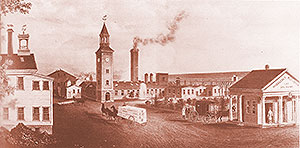
The Bleachery, which produced finished goods made of cotton and stood where the Conway Rink now stands, was one of Somerville’s largest businesses that benefited from the labor of slaves.
By Terence Clarey
The event was almost canceled due to the unpredictability of New England weather but because of heavy interest, the Somerville Museum decided to go ahead with a scaled down version of a lecture celebrating Black History Month entitled The Somerville I Didn’t Know: The Influence of Africans, West Indians and African Americans on Somerville, 1630-1860. The event was introduced by Cambridge African American Heritage Trail Committee member Kathleen Walcott, and featured Somerville native, poet, and storyteller, Alice Mack.
Much is still to be learned of the earliest African American and West Indian peoples who called Somerville home, and sometimes they have been discovered at random. Walcott said she was “floored” when told by the pastor of her church that one of the elderly members, who bore a striking resemblance to escaped slave, author and abolitionist Fredrick Douglass, was none other than his grand niece, Ruth A. Jones. It is believed that Jones was the first black graduate of Somerville High School and may have been one of the first blacks to vote register to vote in Cambridge. Also, because she had such a beautiful voice, may have also been one of the first black telephone operators in the area.
It is known that in Somerville’s early days there was quite a bit of prejudice sentiment in the city against allowing blacks to live and buy property in the city but, in spite of this, an enclave of blacks sprung up in the areas of Somerville and Cambridge that were once the site of Camp Cameron, a way station for Union Troops traveling south to fight in the Civil War. It was close to a branch of the Boston and Maine Railroad and after the war the land was sold off, and many black porters who worked on the trains for a number of years and had saved money, could afford to buy parcels and build their houses in the area around Malvern Ave. and Elmwood.
Alice Mack discussed the role that cotton played as the engine that drove the early American economy after the invention of the cotton gin and increased the demand for slaves. After it was harvested on vast southern plantations, the cotton was sent north to the textile factories in Massachusetts where it was woven into cloth and sent for finishing to places like “The Bleachery” on Somerville Avenue where they produced finished material to be used to produce cloth to be used by clothing manufacturers, and especially the linings of steamer trunks. For a time the Bleachery, which stood on the land now occupied by the Conway Ice Rink, was the biggest business in Somerville and it was all supported by the hard work of African American slaves in the south.
She finished with the story of Peter Still, which played out like a real-life Django Unchained, without all the gratuitous violence. His speaking tour to raise funds to free his family brought him to Somerville where residents took him in and helped him raise a significant amount of money to help his cause.
The uncertainty of putting on the event left the presentation somewhat incomplete, so the lecture will be held again on June 19. There is still much to learn and discover, so between now and then there could be even more history that emerges regarding the African Experience in Somerville in the meantime.
The Somerville Museum will be hosting a fundraiser for building improvements on March 19 at the First Methodist Church at 1 Bow Street in Union Square. Food and beverages will be served and there will also be live music. For more information about upcoming events, to add information about the history of Somerville, or to make a donation to the Somerville Museum, you can visit their website at www.somervillemuseum.org.
















Reader Comments